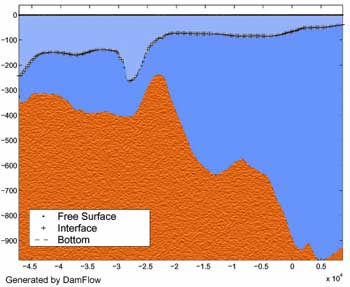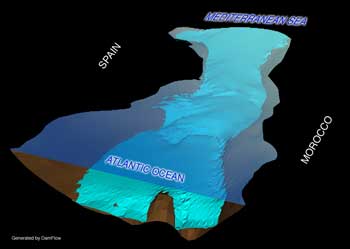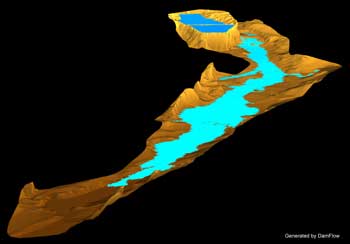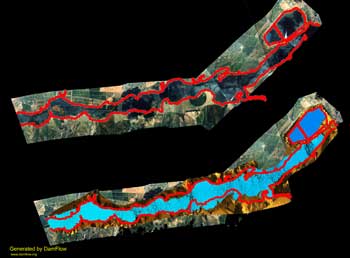
This issue in pdf Subscription Archive: Next issue: July 2005 |
|
||||||||||
Mathematical Models for the Simulation of Environmental Flows: From the Strait of Gibraltar to the Aznalcollar Disasterby Carlos Parés, Jorge Macías, Manuel J. Castro and José M. González-Vida The realistic simulation of environmental flows is a subject of major economic, social, human and scientific interest. Human interaction with natural flows, through adding pollutants or being responsible for disasters such as the dam-break of Aznalcollar, feeds the necessity for numerical modelling and prediction. The DAMFLOW project is looking at the development of efficient techniques for the numerical solution of hydrodynamic flows, with a particular focus on environmental applications. Among the project's aims is the development of robust and reliable numerical tools with low computational cost, which can predict and simulate hazards or emergency situations such as floods or oil spills. These numerical models may also assist, in some particular cases, in understanding the physical nature of the problem and the key processes involved. Currently, a set of fascinating problems has attracted our attention. One of these is the two-layer water masses exchange through the Strait of Gibraltar. The confinement of the flow by a strait can give rise to profound dynamic consequences including choking or hydraulic control, a process similar to that by which a dam regulates the flow from a reservoir. The funnelling geometry can lead to enhanced tidal modulation and increased velocities, giving rise to local instabilities, mixing, internal bores, jumps and other striking hydraulic and fine-scale phenomena. In short, sea straits represent choke points which are observationally and dynamically strategic and which contain a range of interesting processes. The flow configuration in the Strait of Gibraltar is characterized by two counter-currents: at the surface the less saline water of the Atlantic flows eastward, spreading into the Mediterranean and, at depth, the waters of the Mediterranean flow westward toward the Atlantic Ocean. This situation means that it is possible and useful to use two-layer models to represent the region's dynamics and to better understand the key processes involved. As result of the DAMFLOW project, a set of finite-volume two-layer shallow water models have been developed, comprehensively tested, and used to numerically simulate the dynamics of the Strait of Gibraltar. One-dimensional tidal modelling of the Strait (see Figure 1) revealed a complicated pattern of time-dependent hydraulic fluctuations involving changing interfacial levels, moving control points and reversal of the layer flows at different stages of the tide, in good agreement with observations. Two-dimensional modelling (see Figure 2) produces a more complex picture of tidal dynamics for the interpretation of which several numerical and graphical tools have also been developed.
A second environmental problem that deserved our attention was the simulation of the Aznalcollar dam-break. On 25 April 1998, a massive spillage of tailings occurred from a pyrites mine lagoon at Aznalcollar (Seville, Spain) and damaged the environmentally sensitive Doñana region. This caused an estimated economic cost of 300 million euros and an unquantifiable cost in terms of environmental damage. Our project has focused on reproducing the Aznalcollar dam-break conditions in order to assess our model's performance. First, a digital model of the affected area was made from GIS data. A two-dimensional one-layer finite volume model was used (see Figure 3), which showed robust behaviour and produced good results; propagation speeds, the flooded area (see Figure 4) and draught sections were in good agreement with the available data. The model had previously been validated against test cases with analytical solutions and laboratory data. The results provided by the model have given us confidence that this numerical tool can produce and provide a full description of a potential flood wave and flooded area in other scenarios of potential risk. At the present stage of the project:
Numerical modelling and simulation require, besides algorithmic research and implementation, the use of 'interfaces' and other technological developments. In the framework of this project we have also undertaken the following tasks:
This research is partially funded by the C.I.C.Y.T. (Comisión Interministerial de Ciencia y Tecnología), project BFM2003-07530-C02-02, which commenced in December 2003 and will end in December 2006. The research team involved in this project belongs to the Differential Equations, Numerical Analysis and Applications group at the University of Málaga. Close collaborations exist with the Numerical Analysis in Fluid Mechanics group at Seville University led by Tomás Chacón, and other research groups at the Universities of Santiago de Compostela, Zaragoza, Cádiz, I.E.O. (Spanish Institute of Oceanography), CITEEC (University of La Coruña) and Université de Corse (France). Link: Please contact: |
||||||||||





